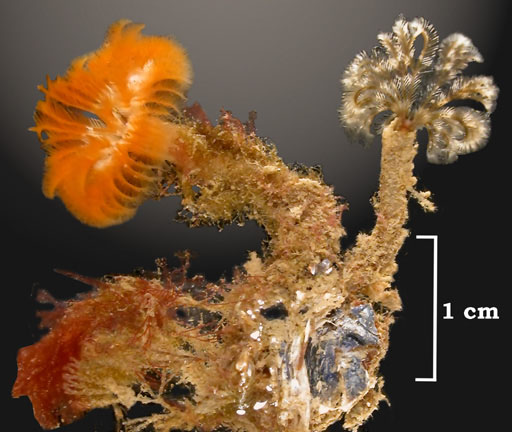California Academy of Sciences
Home What is a Settling Plate? Settling Plate Organisms Participating Schools Get Involved!
Schizobranchia
insignis Bush, 1905 - Native
and
Eudistylia
polymorpha (Johnson, 1901) - Native
The two polychaete worms pictured below are in the family Sabellidae. We have been able to identify the animal on the right as Schizobranchia insignis, a polychaete native to San Francisco Bay, which is commonly found as a fouling organism on floating docks. We have collected this species from several marina locations in the central Bay, but have found none from areas of the Bay with a higher freshwater influx, suggesting that this worm is not very tolerant of salinities significantly lower than those found in the open ocean.
The polychaete on the left with the orange radioles is a juvenile specimen of Eudistylia polymorpha, a worm commonly found in harbors and rocky habitats from Alaska to Southern California. The membranous tubes of this species have been reported to attain lengths of up to 18 inches and are often found lodged in deep crevices of rocky areas. Their plumes of radioles range in color from orange to maroon or brown and sometimes appear banded with lighter pigmentation.
Sabellids are tubiculous (tube dwelling) worms which live with most of their bodies hidden in thick, leathery cylinders which they construct from sediment and mucus that they secrete. Although difficult to see in this photo, there are numerous dark "eyes" along each of the radioles (the feathery structures of the crown) which help the worm to detect movement. However, the eyes are probably only able to detect changes in light levels, without forming actual images. The worms can quickly withdraw their crown of radioles into the protective tube when a shadow passes over them or if they are touched, to avoid predation. The posterior (tail end) of the animal is equipped with specialized structures called uncini (or hooked setae) which help to anchor the worms into their tubes.
The
crown of tentacle-like radioles is used for respiration and feeding. Food
and sediment particles mixed with secreted mucus are moved along a groove
in each radiole towards the animal's mouth. Sediment particles that are too
coarse for ingestion are rejected before reaching the mouth and are redirected
to be incorporated into the animal's tube.


